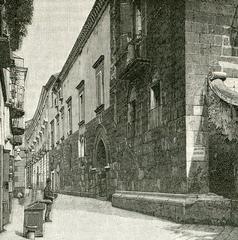Comprehensive Guide to Visiting Anfiteatro Campano in Capua, Italy
Date: 18/07/2024
Introduction
The Anfiteatro Campano, situated in Santa Maria Capua Vetere in Italy, embodies the architectural brilliance and cultural heritage of the Roman Empire. Often overshadowed by Rome’s Colosseum, this amphitheater is the second largest in Italy and offers a unique historical narrative that dates back to the 1st century AD. Constructed during the reign of Emperor Augustus, the Anfiteatro Campano was a central hub for gladiatorial combats, public executions, and other spectacles, reflecting the social and political fabric of ancient Capua (Anfiteatro Campano - History, Visiting Hours, and Tickets). The amphitheater also has a significant connection to the Spartacus revolt, making it not only a monument of Roman power but also a symbol of the human struggle for freedom. Rediscovered in the 18th century, the site’s restoration efforts have gradually revealed its former glory, making it a must-visit for history enthusiasts and tourists alike (Exploring Anfiteatro Campano - Visiting Hours, Tickets, and Key Attractions in Capua). This comprehensive guide aims to provide detailed insights into the history, visiting logistics, and cultural significance of the Anfiteatro Campano, ensuring that visitors can immerse themselves fully in its rich past and present vibrancy.
Table of Contents
- [History of Anfiteatro Campano](#history-of-anfiteatro-campanohistory-of-anfiteatro-campano)
- [The Early Years - Construction and Purpose](#the-early-years---construction-and-purposethe-early-years---construction-and-purpose)
- [More Than Just Games - A Center of Social Life](#more-than-just-games---a-center-of-social-lifemore-than-just-games---a-center-of-social-life)
- [A School for Gladiators - The Ludus Gladiatorius](#a-school-for-gladiators---the-ludus-gladiatoriusa-school-for-gladiators---the-ludus-gladiatorius)
- [Decline and Transformation - From Glory to Ruins](#decline-and-transformation---from-glory-to-ruinsdecline-and-transformation---from-glory-to-ruins)
- [Rediscovery and Restoration - A Second Life](#rediscovery-and-restoration---a-second-liferediscovery-and-restoration---a-second-life)
- [Visiting the Anfiteatro Campano Today](#visiting-the-anfiteatro-campano-todayvisiting-the-anfiteatro-campano-today)
- [Opening Hours and Ticket Prices](#opening-hours-and-ticket-pricesopening-hours-and-ticket-prices)
- [Guided Tours and Events](#guided-tours-and-eventsguided-tours-and-events)
- [Nearby Attractions and Travel Tips](#nearby-attractions-and-travel-tipsnearby-attractions-and-travel-tips)
- [Accessibility Information](#accessibility-informationaccessibility-information)
- [FAQ](#faqfaq)
- [Conclusion](#conclusionconclusion)
- [References](#referencesreferences)
History of Anfiteatro Campano
The Early Years - Construction and Purpose
Built during the 1st century AD, likely under the reign of Emperor Augustus, the Anfiteatro Campano served as a symbol of Roman power and entertainment for the thriving city of Capua, then one of the largest cities in Italy. The amphitheater’s construction, using innovative Roman techniques like the arch and vault, allowed for its immense size and capacity. It is estimated that the amphitheater could accommodate up to 60,000 spectators, highlighting the importance of such venues in Roman society.
The primary purpose of the Anfiteatro Campano was to host gladiatorial combats, a popular form of entertainment in ancient Rome. These brutal spectacles, often involving fights to the death between gladiators or against wild animals, drew massive crowds and served as a means of social control and display of imperial power.
More Than Just Games - A Center of Social Life
Beyond the bloodshed and spectacle, the Anfiteatro Campano played a significant role in the social fabric of Capua. It served as a gathering place for people from all walks of life, a melting pot where social hierarchies blurred amidst the roar of the crowd. The amphitheater also hosted other events, such as public executions, demonstrating the multifaceted nature of these venues in Roman society.
A School for Gladiators - The Ludus Gladiatorius
Adding to its historical significance, the Anfiteatro Campano is intrinsically linked to the Spartacus revolt. In 73 BC, the nearby gladiator training school, the Ludus Gladiatorius, became the epicenter of a slave uprising led by the Thracian gladiator Spartacus. This rebellion, though ultimately crushed by Roman forces, left an indelible mark on Roman history, and the Anfiteatro Campano, standing as a silent witness, became a symbol of both Roman power and the human struggle for freedom.
Decline and Transformation - From Glory to Ruins
With the decline of the Roman Empire, the Anfiteatro Campano, like many other Roman structures, fell into disrepair. The once-grand arena was abandoned and left to the elements, its stone plundered for building materials by later civilizations. Over the centuries, the amphitheater was gradually buried under layers of earth and vegetation, fading from memory and becoming a shadow of its former glory.
Rediscovery and Restoration - A Second Life
The Anfiteatro Campano lay forgotten for centuries until its rediscovery in the 18th century sparked renewed interest in its history and architecture. Excavations and restoration efforts, though intermittent, began in the 19th century and continue to this day, slowly revealing the amphitheater’s impressive structure and offering glimpses into its glorious past.
Visiting the Anfiteatro Campano Today
Opening Hours and Ticket Prices
The Anfiteatro Campano is open to the public year-round. Visiting hours are generally from 9 AM to 5 PM, but it is advisable to check the official website for any changes or seasonal variations. Tickets can be purchased on-site or online, with prices typically ranging from €5 to €10. Discounts are often available for students, seniors, and groups.
Guided Tours and Events
Guided tours are available and highly recommended for gaining deeper insights into the amphitheater’s history, architecture, and significance. The site also hosts occasional events and exhibitions that bring the past to life, offering visitors a unique perspective on this ancient wonder.
Nearby Attractions and Travel Tips
Santa Maria Capua Vetere is rich in historical sites. Nearby attractions include the Mithraeum, an ancient temple dedicated to the god Mithras, and the Museo Archeologico dell’Antica Capua, which houses artifacts from the region. Travel tips include wearing comfortable shoes, as the site involves a fair amount of walking, and bringing water and sun protection during the warmer months.
Accessibility Information
The Anfiteatro Campano strives to be accessible to all visitors. There are ramps and pathways designed for wheelchair access, though some areas may still pose challenges due to the ancient nature of the site. It is recommended to contact the site in advance for detailed accessibility information.
FAQ
Q - What are the opening hours for Anfiteatro Campano?
A - The Anfiteatro Campano is generally open from 9 AM to 5 PM, but it’s best to check the official website for any changes or seasonal variations.
Q - How much are tickets for Anfiteatro Campano?
A - Ticket prices typically range from €5 to €10, with discounts available for students, seniors, and groups.
Q - Is Anfiteatro Campano accessible for disabled visitors?
A - The site has ramps and pathways for wheelchair access, though some areas may still be challenging. Contacting the site in advance for detailed accessibility information is recommended.
Q - Are guided tours available at Anfiteatro Campano?
A - Yes, guided tours are available and highly recommended for a deeper understanding of the site’s history and significance.
Conclusion
A visit to the Anfiteatro Campano is more than just a historical exploration; it is a journey through time that vividly brings to life the grandeur of the Roman Empire. From its towering arches and extensive underground chambers to its significant historical associations with events like the Spartacus revolt, the amphitheater offers a profound connection to the past. Modern-day visitors can appreciate both the architectural marvel and the cultural significance of this ancient site, experiencing firsthand the echoes of gladiatorial combats and public gatherings that once reverberated within its walls (Ultimate Guide to Visiting Anfiteatro Campano - Hours, Tickets, Tips, and More). The site’s accessibility, comprehensive guided tours, and nearby attractions, including the Museo Archeologico dell’Antica Capua and the Mithraeum, provide a well-rounded and enriching visit. By respecting and preserving this monumental relic, we not only honor the ingenuity of Roman engineering but also ensure that future generations can continue to learn from and be inspired by its storied past. For those seeking a deeper understanding of Roman history and architecture, the Anfiteatro Campano stands as an essential destination, inviting all to delve into its timeless legacy.
References
- Anfiteatro Campano - History, Visiting Hours, and Tickets. (2024). Retrieved from Anfiteatro Campano - History, Visiting Hours, and Tickets
- Exploring Anfiteatro Campano - Visiting Hours, Tickets, and Key Attractions in Capua. (2024). Retrieved from Exploring Anfiteatro Campano - Visiting Hours, Tickets, and Key Attractions in Capua
- Ultimate Guide to Visiting Anfiteatro Campano - Hours, Tickets, Tips, and More. (2024). Retrieved from Ultimate Guide to Visiting Anfiteatro Campano - Hours, Tickets, Tips, and More


